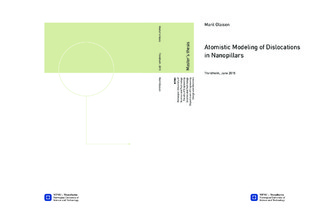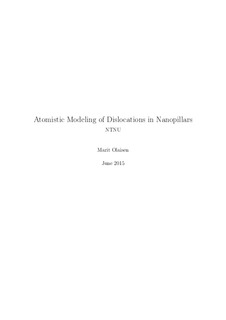| dc.description.abstract | In this master s thesis, atomistic simulations of displacement controlled compression were performed on nanopillars consisting of pure iron. The main part of the work has been put into developing compression simulations of nanopillars with initial dislocations. The purpose of these simulations has mainly been to see if the addition of dislocations prior to deformation of the material, would visibly affect the material properties. Three models of the pillar were developed with different number and positions of dislocations. The simulations were performed both at room temperature and at 15K in order to see how the different temperatures would affect the dislocation behaviour and the overall results. During the work with the thesis, it was also decided to include simulations with different strain rates. All the simulations in this thesis were performed with the simulation tool/code LAMMPS (Large-scale Atomic/Molecular Massively Parallel Simulator)[7] with help from NTNU s supercomputer Vilje [3]. The dislocations were inserted using the program Atomsk [4], and the result was visualized in the analysis software Ovito [5].In addition to performing atomistic simulations, a part regarding experimental compression testing of micro sized iron pillars were included. The goal of this part of the thesis was to get a better understanding of the experimental tests which the pillar simulations are based on. The experimental testing was performed in close collaboration with PhD student Anette B. Hagen. The results showed that the insertion of dislocations into the simulated pillar did not visibly affect the mechanical properties of the sample. Neither the number nor position of dislocations seemed to have any influence on the stress-strain curves acquired from the simulations. The strain rate however was discovered to have the most influence on the stresses measured during the simulations, both with regard to the magnitude and the quality of the results. The dislocation mechanisms observed corresponded well with existing literature as the dislocations showed different behaviour at different temperaturesand different strain rates. | |

